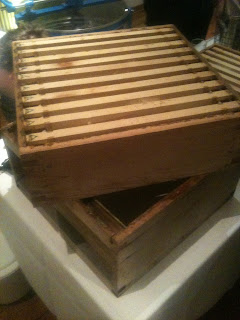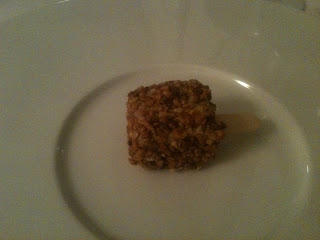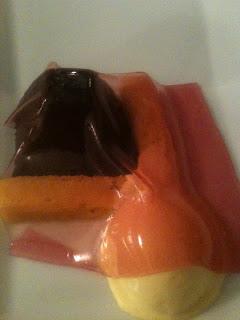There’s no denying it. There’s been an interruption. If you didn’t notice, that’s great. If you did, then I’d be interested to know how you went about noticing an absence of reviews, philosophically speaking.
It all started at Delfina, with honey and a man who keeps bees in Bermondsey. Honey is bee vomit, more or less. I hadn’t known this before. Delfina was pretty good (thanks to Krista Booker for the invite, and please forgive the slapdashery of the belated write-up). We had pork with honey and apple, a shallot and honey fig tart, a honey sorbet, honey cocktails, honey with foie gras, honey with ham hock, and wine that didn’t taste like honey. Dale Gibson, who runs Bermondsey Bees, which produces honey, knows more about honey than anyone I’ve ever met apart from his other beekeeper friend who I met at Delfina, who had won prizes for the excellence of his beekeeping.
I left Delfina full of booze and good intentions, a glittering review literally pushing at the tips of my fingers, itching to escape onto the internet via the magic of a keyboard. Sorry, I’ve misused the word literally there, haven’t I? Well, you know what I mean.
So what happened? It all started in Modena, when I had a bad meal that cost a lot of money, and then a good one that didn’t. I promised in my review of the bad one to follow it with a review of the good one, and then didn’t get around to it and forgot the main details. It seemed (and seems) silly not to keep my promise though. Da Danilo it was called, and utterly brilliant it was too, with a waitress who didn’t charge us for our main course. I queried the bill, and she said that we were such a lovely couple we didn’t have to pay for the main course. I think she may have been insane. The bollito misto was especially wonderful, fatty and gutsy.
So that explains some of what happened. Modena and Delfina. And then there was Hong Kong. I went to Hong Kong for work, intending to review a few restaurants on the side. This is where things really fell down. Sorry – that’s in the wrong order. I went to Duck Soup Soho before Hong Kong. It was overpriced, not as good as Polpetto, dark and skinny-jean trendy.
And then there was Hong Kong. I went to Hong Kong for work, intending to review a few restaurants on the side. This is where things really fell down. I visited about 12 restaurants in Hong Kong, and, almost without exception, they were wonderful. Upstairs in a caff in a shopping mall which I don’t know the name of and where I couldn’t read the menu, was one of the best meals I’ve ever eaten; chicken in sherry at a crappy looking place in the cyberport was marvellous. I said almost without exception. I should have said, with an exception. The only food in the whole city that was not good was at Cafe Deco on the peak, which was not good because it was like a fairly dull French restaurant in Reading, but with a better view. Two exceptions. The McDonald’s at the Happy Valley Racecourse was also not very nice. I don’t remember the names of the good ones. The rule is, if it’s a restaurant with food from a country in the Far East, and it’s in Hong Kong, it will probably be brilliant. And eat dim sum whenever you can, wherever you can, every day. Two rules.
I seem to spend my life in Russell Norman’s restaurants, and my life in December was no exception (apart from when I was somewhere else). Mishkin’s is much the best of the recent crop – the salt beef sandwich (fat on, of course) was jaw dropping, by which I don’t mean merely chewy. And Maureen Lipman was eating in the corner.
At Koffmann’s a few days later, there was no Maureen Lipman. There wasn’t anyone from a British Telecom ad at all. Not a good start. The food was fine for the lunch menu price of £25.50, but unremarkable, which in itself should be remarkable given the pedigree of the chef-patron, but actually returns full-circle to unremarkability when you consider that Koffmann’s seems more like a money-making exercise than an expression of culinary genius. The restaurant has an unfortunate atmosphere too; a place for hedge funders and Harrodians to go and be boring.
Then Bacchus in Hoxton served nice steak and excellent Einstok beer. And I’ll refer you to my tweet about Sushi Say in Willesden: ‘Sushi Say for 1st time. OMFG. Jellyfish, monkfish livers, salmon roe sushi amazing. Also, Japan Olympic badminton team have already booked.’ It’s as true today as it was then. The Japanese Olympic badminton team have booked out the whole restaurant for the duration of the Olympics. So, the next time you’re running a restaurant-themed pub quiz, you can ask: ‘Which restaurant did the Japanese Olympic badminton team book out for the duration of the 2012 London Olympics?’ And you’ll know the answer. It will be Sushi Say.
And other restaurant meals, I’ve had a few, but then again, too many to remember. But I did go to Leon De Bruxelles on Cambridge Circus two weeks ago, and did not enjoy it very much at all. If you are going to make serving mussels the entire selling point of your restaurant, you should be serving mussels that are nice. Just a thought.
I seem to have digressed from my explanation of the interruption to blogging service. It’s partly to do with Hong Kong, and the impossibility of doing justice to the food in that city, but there's more to it than that, and it’s to do with time. Specifically, not having enough of it – trying to write on trains, trying to write before leaving for work in the morning, trying to write while dinner is in the oven, trying to write on planes. Mostly failing.
It all started at Delfina, with honey and a man who keeps bees in Bermondsey. Honey is bee vomit, more or less. I hadn’t known this before. Delfina was pretty good (thanks to Krista Booker for the invite, and please forgive the slapdashery of the belated write-up). We had pork with honey and apple, a shallot and honey fig tart, a honey sorbet, honey cocktails, honey with foie gras, honey with ham hock, and wine that didn’t taste like honey. Dale Gibson, who runs Bermondsey Bees, which produces honey, knows more about honey than anyone I’ve ever met apart from his other beekeeper friend who I met at Delfina, who had won prizes for the excellence of his beekeeping.
I left Delfina full of booze and good intentions, a glittering review literally pushing at the tips of my fingers, itching to escape onto the internet via the magic of a keyboard. Sorry, I’ve misused the word literally there, haven’t I? Well, you know what I mean.
So what happened? It all started in Modena, when I had a bad meal that cost a lot of money, and then a good one that didn’t. I promised in my review of the bad one to follow it with a review of the good one, and then didn’t get around to it and forgot the main details. It seemed (and seems) silly not to keep my promise though. Da Danilo it was called, and utterly brilliant it was too, with a waitress who didn’t charge us for our main course. I queried the bill, and she said that we were such a lovely couple we didn’t have to pay for the main course. I think she may have been insane. The bollito misto was especially wonderful, fatty and gutsy.
So that explains some of what happened. Modena and Delfina. And then there was Hong Kong. I went to Hong Kong for work, intending to review a few restaurants on the side. This is where things really fell down. Sorry – that’s in the wrong order. I went to Duck Soup Soho before Hong Kong. It was overpriced, not as good as Polpetto, dark and skinny-jean trendy.
And then there was Hong Kong. I went to Hong Kong for work, intending to review a few restaurants on the side. This is where things really fell down. I visited about 12 restaurants in Hong Kong, and, almost without exception, they were wonderful. Upstairs in a caff in a shopping mall which I don’t know the name of and where I couldn’t read the menu, was one of the best meals I’ve ever eaten; chicken in sherry at a crappy looking place in the cyberport was marvellous. I said almost without exception. I should have said, with an exception. The only food in the whole city that was not good was at Cafe Deco on the peak, which was not good because it was like a fairly dull French restaurant in Reading, but with a better view. Two exceptions. The McDonald’s at the Happy Valley Racecourse was also not very nice. I don’t remember the names of the good ones. The rule is, if it’s a restaurant with food from a country in the Far East, and it’s in Hong Kong, it will probably be brilliant. And eat dim sum whenever you can, wherever you can, every day. Two rules.
I seem to spend my life in Russell Norman’s restaurants, and my life in December was no exception (apart from when I was somewhere else). Mishkin’s is much the best of the recent crop – the salt beef sandwich (fat on, of course) was jaw dropping, by which I don’t mean merely chewy. And Maureen Lipman was eating in the corner.
At Koffmann’s a few days later, there was no Maureen Lipman. There wasn’t anyone from a British Telecom ad at all. Not a good start. The food was fine for the lunch menu price of £25.50, but unremarkable, which in itself should be remarkable given the pedigree of the chef-patron, but actually returns full-circle to unremarkability when you consider that Koffmann’s seems more like a money-making exercise than an expression of culinary genius. The restaurant has an unfortunate atmosphere too; a place for hedge funders and Harrodians to go and be boring.
Then Bacchus in Hoxton served nice steak and excellent Einstok beer. And I’ll refer you to my tweet about Sushi Say in Willesden: ‘Sushi Say for 1st time. OMFG. Jellyfish, monkfish livers, salmon roe sushi amazing. Also, Japan Olympic badminton team have already booked.’ It’s as true today as it was then. The Japanese Olympic badminton team have booked out the whole restaurant for the duration of the Olympics. So, the next time you’re running a restaurant-themed pub quiz, you can ask: ‘Which restaurant did the Japanese Olympic badminton team book out for the duration of the 2012 London Olympics?’ And you’ll know the answer. It will be Sushi Say.
I seem to have digressed from my explanation of the interruption to blogging service. It’s partly to do with Hong Kong, and the impossibility of doing justice to the food in that city, but there's more to it than that, and it’s to do with time. Specifically, not having enough of it – trying to write on trains, trying to write before leaving for work in the morning, trying to write while dinner is in the oven, trying to write on planes. Mostly failing.



















